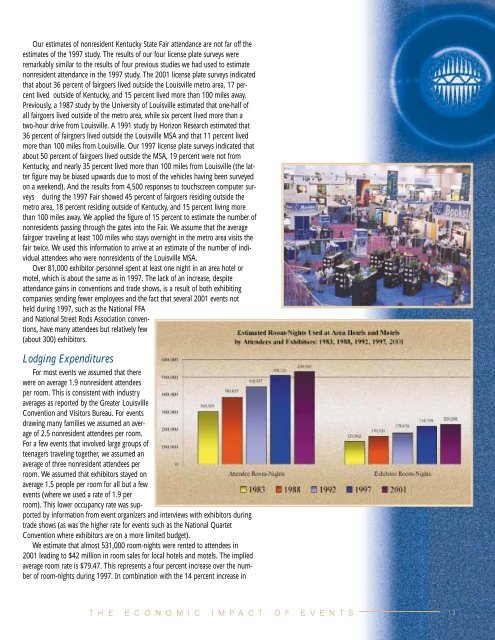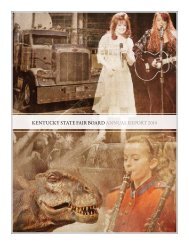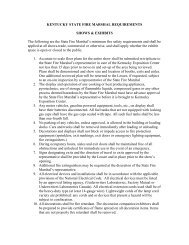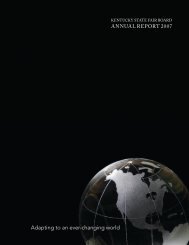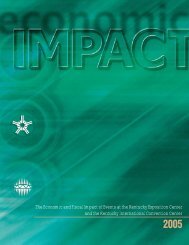2001 Economic Impact Study of the Kentucky State Fair Board
2001 Economic Impact Study of the Kentucky State Fair Board
2001 Economic Impact Study of the Kentucky State Fair Board
Create successful ePaper yourself
Turn your PDF publications into a flip-book with our unique Google optimized e-Paper software.
Our estimates <strong>of</strong> nonresident <strong>Kentucky</strong> <strong>State</strong> <strong>Fair</strong> attendance are not far <strong>of</strong>f <strong>the</strong><br />
estimates <strong>of</strong> <strong>the</strong> 1997 study. The results <strong>of</strong> our four license plate surveys were<br />
remarkably similar to <strong>the</strong> results <strong>of</strong> four previous studies we had used to estimate<br />
nonresident attendance in <strong>the</strong> 1997 study. The <strong>2001</strong> license plate surveys indicated<br />
that about 36 percent <strong>of</strong> fairgoers lived outside <strong>the</strong> Louisville metro area, 17 percent<br />
lived outside <strong>of</strong> <strong>Kentucky</strong>, and 15 percent lived more than 100 miles away.<br />
Previously, a 1987 study by <strong>the</strong> University <strong>of</strong> Louisville estimated that one-half <strong>of</strong><br />
all fairgoers lived outside <strong>of</strong> <strong>the</strong> metro area, while six percent lived more than a<br />
two-hour drive from Louisville. A 1991 study by Horizon Research estimated that<br />
36 percent <strong>of</strong> fairgoers lived outside <strong>the</strong> Louisville MSA and that 11 percent lived<br />
more than 100 miles from Louisville. Our 1997 license plate surveys indicated that<br />
about 50 percent <strong>of</strong> fairgoers lived outside <strong>the</strong> MSA, 19 percent were not from<br />
<strong>Kentucky</strong>, and nearly 35 percent lived more than 100 miles from Louisville (<strong>the</strong> latter<br />
figure may be biased upwards due to most <strong>of</strong> <strong>the</strong> vehicles having been surveyed<br />
on a weekend). And <strong>the</strong> results from 4,500 responses to touchscreen computer surveys<br />
during <strong>the</strong> 1997 <strong>Fair</strong> showed 45 percent <strong>of</strong> fairgoers residing outside <strong>the</strong><br />
metro area, 18 percent residing outside <strong>of</strong> <strong>Kentucky</strong>, and 15 percent living more<br />
than 100 miles away. We applied <strong>the</strong> figure <strong>of</strong> 15 percent to estimate <strong>the</strong> number <strong>of</strong><br />
nonresidents passing through <strong>the</strong> gates into <strong>the</strong> <strong>Fair</strong>. We assume that <strong>the</strong> average<br />
fairgoer traveling at least 100 miles who stays overnight in <strong>the</strong> metro area visits <strong>the</strong><br />
fair twice. We used this information to arrive at an estimate <strong>of</strong> <strong>the</strong> number <strong>of</strong> individual<br />
attendees who were nonresidents <strong>of</strong> <strong>the</strong> Louisville MSA.<br />
Over 81,000 exhibitor personnel spent at least one night in an area hotel or<br />
motel, which is about <strong>the</strong> same as in 1997. The lack <strong>of</strong> an increase, despite<br />
attendance gains in conventions and trade shows, is a result <strong>of</strong> both exhibiting<br />
companies sending fewer employees and <strong>the</strong> fact that several <strong>2001</strong> events not<br />
held during 1997, such as <strong>the</strong> National FFA<br />
and National Street Rods Association conventions,<br />
have many attendees but relatively few<br />
(about 300) exhibitors.<br />
Lodging Expenditures<br />
For most events we assumed that <strong>the</strong>re<br />
were on average 1.9 nonresident attendees<br />
per room. This is consistent with industry<br />
averages as reported by <strong>the</strong> Greater Louisville<br />
Convention and Visitors Bureau. For events<br />
drawing many families we assumed an average<br />
<strong>of</strong> 2.5 nonresident attendees per room.<br />
For a few events that involved large groups <strong>of</strong><br />
teenagers traveling toge<strong>the</strong>r, we assumed an<br />
average <strong>of</strong> three nonresident attendees per<br />
room. We assumed that exhibitors stayed on<br />
average 1.5 people per room for all but a few<br />
events (where we used a rate <strong>of</strong> 1.9 per<br />
room). This lower occupancy rate was supported<br />
by information from event organizers and interviews with exhibitors during<br />
trade shows (as was <strong>the</strong> higher rate for events such as <strong>the</strong> National Quartet<br />
Convention where exhibitors are on a more limited budget).<br />
We estimate that almost 531,000 room-nights were rented to attendees in<br />
<strong>2001</strong> leading to $42 million in room sales for local hotels and motels. The implied<br />
average room rate is $79.47. This represents a four percent increase over <strong>the</strong> number<br />
<strong>of</strong> room-nights during 1997. In combination with <strong>the</strong> 14 percent increase in<br />
T H E E C O N O M I C I M P A C T O F E V E N T S<br />
13


